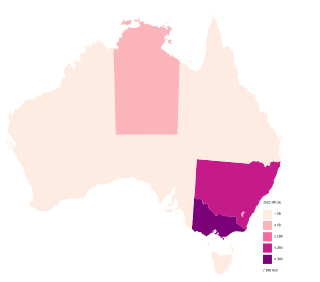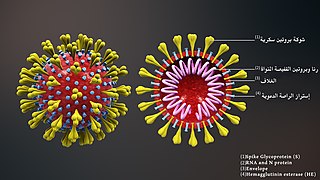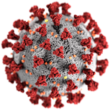
The 2019–20 coronavirus pandemic was confirmed to have reached Australia on 25 January 2020 in Victoria, when a man returning from Wuhan, Hubei, China, was tested positive for SARS-CoV-2.

The ongoing 2019–20 coronavirus pandemic spread to South Africa with Minister of Health Zweli Mkhize announcing the first confirmed case on 5 March 2020, the patient being a South African returning from Italy.
The 2020 coronavirus pandemic in Jamaica is part of an ongoing global pandemic of coronavirus disease 2019 (COVID-19), an infectious disease caused by severe acute respiratory syndrome coronavirus 2 (SARS-CoV-2). On 12 January, the World Health Organization (WHO) confirmed that a novel coronavirus was the cause of a respiratory illness in a cluster of people in Wuhan City, Hubei Province, China, who had initially come to the attention of the WHO on 31 December 2019. Unlike SARS outbreak of 2003, the case fatality ratio for COVID-19 has been much lower, but the transmission has been significantly greater, with a significant total death toll.

The first cases of the global pandemic of coronavirus disease 2019 (COVID-19) in Washington, D.C. were reported on March 7, 2020.

The 2019–20 coronavirus pandemic was confirmed to have reached the U.S. state of Maryland in March 2020. The first three cases of the virus were reported in Montgomery County on March 5, 2020. As of May 2, 2020, the Maryland Department of Health (MDH) reported 24,473 positive cases and 1,156 deaths in the state, with 1,590 patients released from isolation. All of the state's 23 counties and the independent city of Baltimore have at least one coronavirus case.

The 2020 coronavirus Pandemic in Ghana is an ongoing viral pandemic of coronavirus disease 2019 (COVID-19), a novel infectious disease caused by severe acute respiratory syndrome coronavirus 2 (SARS-CoV-2). The first two cases of COVID-19 in Ghana during the 2019–20 worldwide pandemic was confirmed on 12 March 2020, when two people returned from Norway and Turkey.

The 2019–20 coronavirus pandemic was reported to have reached the U.S. state of Delaware on March 11, 2020, in New Castle County. As of April 30, 2020, the Delaware Department of Health and Social Services has confirmed 4,734 positive cases and 152 deaths in the state, with 1,275 people being fully recovered.

The 2019–20 coronavirus pandemic was confirmed to have reached the U.S. state of Indiana in March 6, 2020. As of May 2, 2020, the Indiana State Department of Health (ISDH) had confirmed 19,295 cases in the state and 1,115 deaths.

The first presumptive case of coronavirus disease 2019 (COVID-19) in Louisiana was announced on March 9, 2020. Since the first confirmed case, the outbreak grew particularly fast relative to other states and countries. As of April 21, 2020, there have been 24,854 confirmed cases in Louisiana, and of those 1,405 people have died. Confirmed cases have appeared in all 64 parishes, though the New Orleans metro area alone has seen the majority of positive tests and deaths. Governor John Bel Edwards closed schools statewide on March 16, 2020, restricted most businesses to takeout and delivery only, postponed presidential primaries, and placed limitations on large gatherings. On March 23, Edwards enacted a statewide stay-at-home order to encourage social distancing, and President Donald Trump issued a major disaster declaration, the fourth state to receive one.
The 2019–20 coronavirus pandemic was confirmed to have reached the U.S. state of Missouri in March 2020. As of April 27, 2020, the Missouri Department of Health and Senior Services has confirmed 7,171 cases and 288 deaths in the state.

The 2019–20 coronavirus pandemic was confirmed to have reached the U.S. state of New Mexico in March 11, 2020.

The American state of Ohio was affected by the viral pandemic of coronavirus disease 2019 (COVID-19). Acting on advice from Ohio's Department of Health director Amy Acton, Governor Mike DeWine declared a state of emergency on March 9 when the state had only three confirmed cases and no deaths. Acton issued a stay-at-home order effective March 23.

The 2019–20 coronavirus pandemic was confirmed to have reached the U.S. state of Oklahoma in March 7, 2020. The first death occurred in Oklahoma on March 15.

The 2019–20 coronavirus pandemic was confirmed to have reached the U.S. state of Pennsylvania in March 2020. As of May 1, 2020, the Pennsylvania Department of Health has confirmed 46,971 cases and 2,354 deaths in the state.

The 2019–20 coronavirus pandemic was confirmed to have reached the U.S. state of South Carolina in March 2020. As of April 29, 2020, the South Carolina Department of Health and Environmental Control has confirmed 5,881 cases in the state, resulting in 232 deaths. On April 2, 2020, DHEC announced that the virus had spread to all 46 counties in the state.

The 2019–20 coronavirus pandemic was confirmed to have reached the U.S. state of Tennessee on March 5, 2020. As of May 2, 2020, there are 12,661 confirmed cases, 209 deaths, and 5,718 recoveries.

The 2020 coronavirus pandemic in Virginia is part of an ongoing pandemic of coronavirus (COVID-19) in the world. The first confirmed case was reported on March 7, 2020. As of May 1, 2020, there have been 16,901 confirmed cases and 581 deaths reported in the U.S. state of Virginia.
The following is a timeline of the 2020 coronavirus pandemic in the United States.
The ongoing coronavirus pandemic reached Northern Ireland on 29 February 2020. According to the Department of Health, 365 people have died after testing positive for coronavirus, both in hospitals and care homes. Northern Ireland has the lowest recorded coronavirus death rate in the United Kingdom and a lower rate than the Republic of Ireland. It is also carrying out more tests per capita than the other countries of the United Kingdom.
















